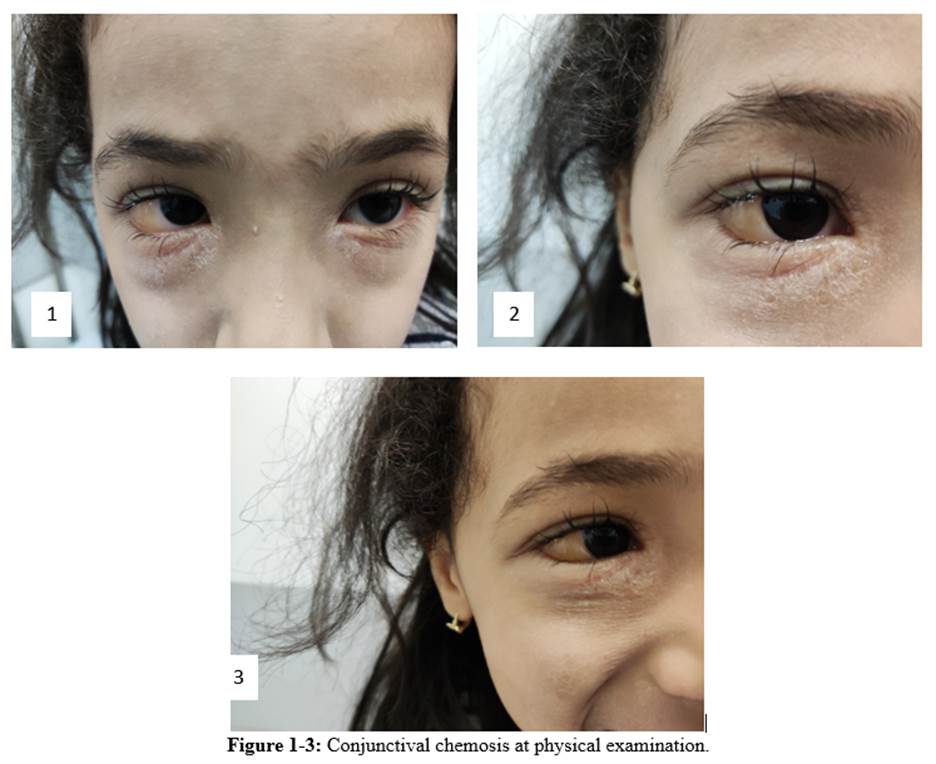Clinical Case Reports and Clinical Study
OPEN ACCESS | Volume 12 - Issue 5 - 2025
ISSN No: 2766-8614 | Journal DOI: 10.61148/2766-8614/JCCRCS
Short title: Chemosis as Manifestation of Egg Allergy
Ana Isabel Moreira Ribeiro1*, Rita Lages Pereira2, Ivo Miguel Neves3, Fábia Ginja de Carvalho4
1Pediatric Department, Local Health Unit Braga, Portugal.
2Pediatric Department, Local Health Unit Braga, Portugal.
3Pediatric Department, Local Health Unit Braga, Portugal.
4Pediatric Department, Local Health Unit Braga, Portugal.
*Corresponding author: Ana Isabel da Silva Moreira Barros Ribeiro, Department of Pediatrics, Hospital de Braga, Sete Fontes — São Victor, 4710-243 Braga, Portugal.
Received: July 14, 2025 |Accepted: July 21, 2025 |Published: July 28, 2025
Citation: Ana Isabel Moreira Ribeiro, Rita Lages Pereira, Ivo Miguel Neves, Fábia Ginja de Carvalho, (2025) “Conjunctival Chemosis as an Initial Manifestation of Egg Allergy in a 4-Year-Old Child” Clinical Case Reports and Clinical Study, 12(3); DOI: 10.61148/2766-8614/JCCRCS/212.
Copyright: © 2025 Ana Isabel da Silva Moreira Barros Ribeiro. This is an open access article distributed under the Creative Commons Attribution License, which permits unrestricted use, distribution, and reproduction in any medium, provided the original work is properly cited.
A four-year-old child presented to the Emergency Department with cutaneous and ocular pruritus and periorbital edema following contact with eggs. The child's medical history included atopic eczema and perennial allergic rhinitis, with sensitization to dust mites and grasses. Examination revealed conjunctival chemosis, but no respiratory, gastrointestinal, or significant skin symptoms were noted. The child was treated with antihistamines and hydrocortisone eye drops and referred to Pediatric Allergology. Laboratory investigations showed elevated total IgE levels (2455 U/L) and positive skin prick tests for ovalbumin, while other allergens tested negative. Further assessment with ImmunoCAP ISAC® confirmed allergies to egg white components. An oral provocation test was positive, resulting in abdominal pain and vomiting. The child was advised to consume small quantities of poorly cooked egg while regularly eating well-cooked egg. Since the intervention, no further allergic reactions have occurred. This case emphasizes the need for thorough clinical assessment in diagnosing food allergies, particularly when presenting symptoms include conjunctival chemosis, and underscores the importance of caregiver vigilance regarding potential allergens in children's diets.
Clinical Report:
A four-year-old child was admitted to the Emergency Department with cutaneous and ocular pruritus and periorbital edema following egg contact. The child medical history included atopic eczema and perennial allergic rhinitis, sensitized to dust mites and grasses. Examination highlighted conjunctival chemosis (Figures 1-3), while other physical findings were unremarkable, with no edema of lips or tongue, and o respiratory, gastrointestinal, or additional skin symptoms. The patient was discharged with antihistamine and hydrocortisone eye drops, with a referral to Pediatric Allergology. Investigations indicated a total IgE level of 2455 U/L. Skin prick tests revealed a wheal of 5 mm in response to ovalbumin, with a positive control for histamine at 6 mm.
All other allergens tested (including Dermatophagoides farinae, Lepidoglyphus destructor, Alternaria, Wild Grasses, Cultivated Grasses, cat, dog, S. farinaceus, egg yolk, egg white, ovomucoid, cow’s milk, casein, profilin, LTP, kiwi, walnut, almond, peanut, hazelnut, chestnut, and soybean seeds) returned negative results. Further evaluation with Immuno CAP ISAC® confirmed an allergy to egg white (Gal d 1 Ovomucoid - 2.5 ISU-E and Gal d 3 Conalbumin/Ovotransferrin - 12 ISU-E). An oral provocation test was positive after the intake of 32% of the total food, leading to the test being discontinued after the 6th dose due to abdominal pain and vomiting. The child was advised to consume small quantities of poorly cooked egg while regularly eating well-cooked egg. No further allergic reactions have occurred since.

Figure 1-3: Conjunctival chemosis at physical examination.
Discussion: Conjunctival chemosis is commonly encountered in ophthalmology emergency departments and presents with a wide range of etiologies and severity. Although the majority of cases have an ocular origin, a thorough clinical history and detailed physical examination are crucial for diagnosing systemic causes. [1]This case highlights conjunctival chemosis as an initial manifestation of hypersensitivity reaction to egg. Recognizing this symptom as related to a potential food allergy can lead to timely diagnosis and appropriate management strategies to prevent further complications. Parents and caregivers should always consult healthcare professionals if they notice unusual symptoms in their children, especially after eating potentially allergenic foods.